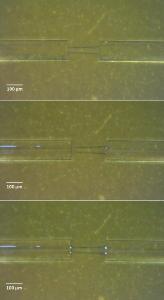North Carolina State University (NC State) researchers have designed a self-repairing sensor for measuring strain in structural materials.
 The top image shows the polymer filament connecting the glass fibers in the sensor. The middle image shows where the filament has snapped off. The bottom image shows where the resin has rushed into the gap, been exposed to UV light and reconnected the filament -- effectively repairing itself.
The top image shows the polymer filament connecting the glass fibers in the sensor. The middle image shows where the filament has snapped off. The bottom image shows where the resin has rushed into the gap, been exposed to UV light and reconnected the filament -- effectively repairing itself.
Sensors are used to measure and monitor the forces that are exerted on materials, in varied industries, including civil infrastructure and airplanes. They can warn about materials or components that are about to fail as well as their performance during usage. Due to stress or other factors, the sensors may break and monitoring information would not be transmitted. In certain cases, it may be difficult to replace the sensors.
The new sensor developed at the university has the ability to compress and stretch along with the structural material it monitors. The strain on the material is detected by an infrared light wave that senses the changes in length.
The sensor includes a reservoir of ultraviolet-curable resin and two optical fibers. Ultraviolet light and infrared beams are made to run through one of the two glass fibers. The resin hardens when a beam of ultraviolet light hits, and a thin polymer filament connecting the two optical glass fibers is formed. This leads to a closed circuit. The remaining resin surrounds the filament and continues to be in liquid form.
The polymer filament may break under stress, and when it does it causes the remaining liquid resin to flow into the gap and harden on contact with the ultraviolet light beam, and the sensor gets automatically repaired.